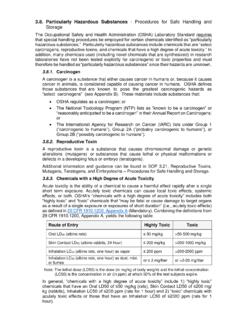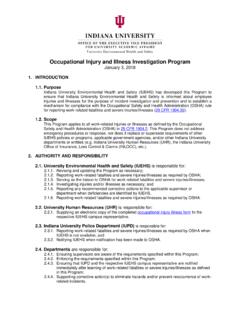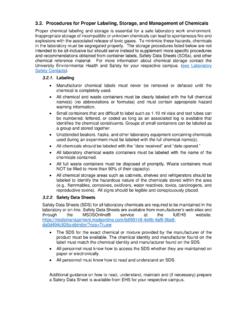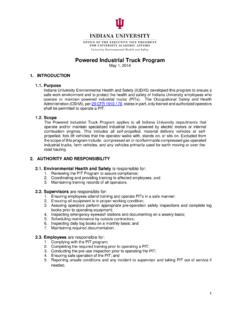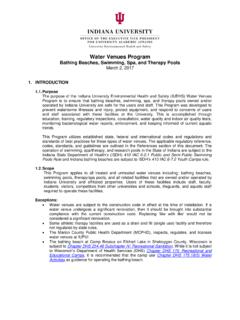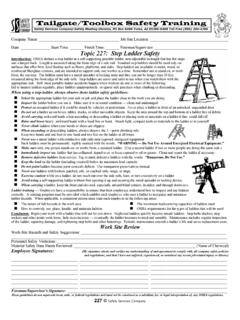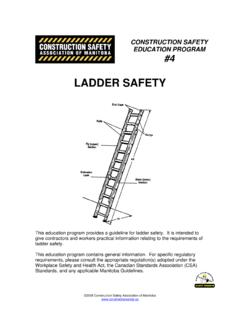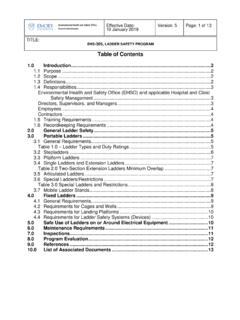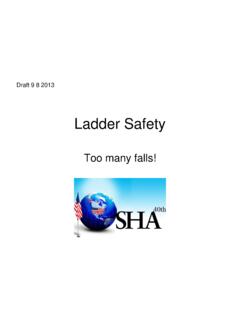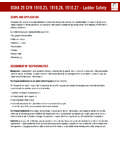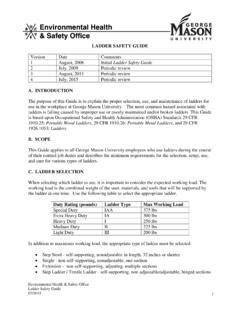Transcription of Portable Ladder Safety Program - Protect IU
1 1 Portable Ladder Safety Program April 30, 2014 1. INTRODUCTION Purpose Indiana University has developed the Portable Ladder Safety Program to safeguard employees that perform work with Portable ladders. This Program is intended to prevent Ladder -related incidents and to promote compliance with the Occupational Safety and Health Administration (OSHA) Standards contained within 29 CFR and Scope The Portable Ladder Safety Program establishes training and standard procedures for all Indiana University employees that use Portable ladders at work. This Program pertains to the use of the following ladders: step ladders, straight ladders, extension ladders, and other variations of Portable utility ladders. This Program does not apply to step stools less than 3 feet in height.
2 2. AUTHORITY AND RESPONSIBILITY Environmental Health and Safety is responsible for: Developing, updating, and promulgating training and guidelines; Maintaining training records; Validating Program implementation; and Revising and updating the Program as necessary. Supervisors are responsible for: Ensuring that applicable personnel have been trained; Ensuring that applicable personnel comply with this Program ; Removing defective, damaged, or prohibited ladders from service; and Conducting periodic visual inspections of ladders to ensure integrity. Employees are responsible for: Completing applicable training; Complying with the requirements of this Program ; Conducting visual inspections of ladders prior to use for defects and damage; Ensuring safe conditions prior to use; and Removing defective, damaged, or prohibited ladders from service.
3 3. Program ELEMENTS Ladder Types This Program applies to four primary Portable Ladder types: step-ladders, straight ladders, extension ladders, and extension trestle ladders. A step- Ladder is a self-supporting Ladder , non-adjustable in length, having flat steps and a hinged back. A single straight Ladder is nonadjustable in length, consisting of only one section, while an extension Ladder is a Portable Ladder adjustable in length, consisting of multiple sections. Ladder Composition 2 The rails on a Ladder are generally composed of wood, metal, or fiberglass. The following information outlines important details regarding the different properties of these materials as they apply to ladders. Although all three of these materials are discussed in this Program , please refer to the campus-specific appendix (See Appendix A) for more details regarding use and application of these Ladder compositions on each campus.
4 Wood Ladders Wood ladders are electrically non-conductive and are the best natural insulator against heat. However, they can be electrically conductive if wet. Wood ladders are heavier than metal and susceptible to rotting and splitting in the absence of a protective finish. Metal Ladders Metal ladders are relatively strong and lightweight, but they are prone to dent, bend, and conduct heat. They must not be used when working on or near electrical wires or when working around energy sources. Metal ladders must be labeled with a DANGER sticker indicating an electrocution hazard. Fiberglass Ladders Fiberglass ladders are strong and electrically non-conductive, but they are generally heavier than metal ladders. Fiberglass may chip or crack upon impact, and when overloaded, fiberglass may crack to the point of failure.
5 Ladder Selection The type and composition of a Ladder necessary for a particular job shall be determined based upon the specific task and requirements outlined in the campus-specific appendix (See Appendix A). In addition, the American National Standards Institute (ANSI) requires that a duty rating sticker be placed on the side of each Ladder . When selecting a Ladder , ensure that the Ladder has an adequate proper duty rating to support the combined weight of the user and the material. Materials include the weight of clothing, protective equipment, and supplies being carried or stored on the Ladder . The Ladder duty ratings are as follows: Type IAA (Extra Heavy Special Duty Industrial) : for heavy duty, such as utilities, contractors, and industrial use.
6 Load capacity not to exceed 375 pounds. Type 1A (Extra Heavy Duty Industrial): for heavy duty, such as utilities, contractors, and industrial use. Load capacity not to exceed 300 pounds. Type I (Industrial): for heavy duty, such as utilities, contractors, and industrial use. Load capacity not to exceed 250 pounds. Type II (Commercial): for medium duty, such as painters, offices, and light industrial use. Load capacity not to exceed 225 pounds. Type III (Household): for light duty, such as light household use. Load capacity not to exceed 200 pounds. Ladder Inspection & Repairs Each user shall inspect the Ladder prior to use. The user performing the inspection shall visually inspect and confirm that applicable criteria are met within the Portable Ladder Inspection Checklist (See Appendix B-1).
7 A user shall re-inspect the Ladder immediately after events that could impact the integrity of the Ladder ( dropping the Ladder or transporting the Ladder ). Ladders that do not meet the requirements of the Portable Ladder Inspection Checklist shall be tagged as Dangerous, Do Not Use and removed from service immediately. Improvised repairs shall not be made to ladders. Only repairs that restore the Ladder to the manufacturer s design specifications are permitted under this Program . In addition, wood ladders shall not be painted with an opaque finish or coated with any material that may hide defects. Ladder Storage & Transport 3 As a best practice, ladders should be stored in a location out of direct sunlight and away from chemicals or materials that may cause decay or damage.
8 Materials shall never be stored on a Ladder or hung from a Ladder in storage. All ladders shall be secured during transport to prevent damage. Ladder Setup & Securement Employees shall ensure that the following proper use criteria are met prior to setup: Ladders shall be set-up on a flat, level surface; Ladders shall not be placed in front of a door opening unless the door is blocked open, locked, or guarded; Ladders shall not be used horizontally as a platform, a runway, or scaffold; Ladders shall not be placed on boxes, barrels, or other unstable bases to obtain additional height; The area around a Ladder must remain clear from debris, equipment, etc; Ladders shall not be loaded beyond the maximum intended load for which they were built, nor beyond their manufacturer s rated capacity; Ladders shall not be setup or used outdoors during wind speeds exceeding 20 miles per hour.
9 Ladders shall not be setup or used on slippery surfaces such as snow, ice, or oily deposits; Ladders shall not be used by more than one employee at a time; The maximum length of a step- Ladder shall not exceed 20 feet, a single straight Ladder shall not exceed 30 feet, and an extension Ladder shall not exceed 36 feet. Aerial lifts or other means should be used for heights exceeding 36 feet; Shorter ladders shall not be spliced together to create longer sections; and Standing ladders shall not be left unattended. Employees shall setup the Ladder according to the following chronological steps depending on the type of Ladder : Step-Ladders a) Lay the step- Ladder on the ground, and extend and lock the metal spreaders in place. b) Lift the Ladder from the top and walk it up until the Ladder is sitting on all four feet.
10 C) If the Ladder is large or the task is too difficult alone, ask for help to setup the Ladder . Using two people, raise the Ladder like one would a straight Ladder . Have one person on the front side rails and the other person on the back side rails. Separate the front from the back by walking in opposite directions. Ensure the spreader is engaged and the hinge is locked. d) Once the Ladder is in the upright position, the metal spreader shall be checked again to ensure that the spreader is locked prior to use. A step- Ladder shall not be used in a folded position. Straight and Extension Ladders a) Lay the Ladder on the ground with the base resting against the bottom of a wall and the top pointing away from the wall. b) Starting at the top, lift the Ladder over your head and walk under the Ladder to the wall.
